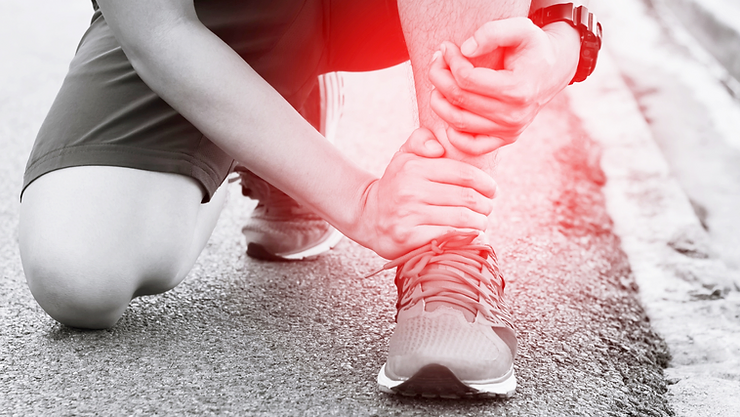How often do you reach for Advil or Motrin at the first sign of pain or running injury? I bet it’s a pretty common practice for some of you. Even though there is more and more research against the use of NSAIDs (non-steroidal anti-inflammatory drugs) such as Advil, it’s still very commonly prescribed by physicians.
Why? I think it’s because it’s easy. It does help with pain and makes us feel good, and it doesn’t require much work. Swallow a pill, feel better, easy! But quick fixes are not always the best fixes.
When we initially get a running injury, think of it as a demolition site. Something gets torn down (hopefully just a small section of the interior wall and not the whole building!) and then a crew of people come in to secure the site and clean it up. The yellow tape is the nociceptors or the chemicals that cause pain. They protect the area by keeping you from doing too much because it hurts. The clean-up crew is the inflammatory chemicals that come into the area that prepare for the rebuild, the healing.
When we take NSAIDs, we are limiting the ability of the clean-up crew to come and go and prepare the area for optimal healing. This can also be limited by icing and resting.* Ideally, you want to keep that blood flowing.
Eventually, if clean-up happens as it should, the repair crew can come in and get you on your way to healing.
In addition, NSAIDs come with a risk. These drugs can weaken your stomach lining, leading to dangerous ulcers. They also affect the gut biome, weakening your immune system and further increasing inflammation.
Here are some things to do instead of NSAIDs and R.I.C.E for acute injuries:
LET THE INFLAMMATION HAPPEN As I said above, inflammation is supposed to be there. It’s important for an optimal healing timeline. Avoid anti-inflammatories such as NSAIDs and ice. It can be helpful to control excessive swelling, the type that blows your ankle or knee up to the size of a grapefruit. You can do this with elevation, compression, and movement.
MOVE Movement has replaced “rest” in the R.I.C.E. (rest, ice, compression, elevation) method. As long as you have been cleared of any serious injury that requires immobilization (fractures), movement is the best medicine. It keeps the blood flowing and prevents the dysfunction that comes from avoiding an injured area (limping, etc). Check in with an expert and then move as soon as you have the ok to do so. A rehab specialist can help you figure out how and when to move to avoid regression of your injury and promote a quicker return to activity.
MANAGE PAIN NSAIDs and ice can be easy to gravitate toward when you have pain. There are several things you can try first. Deep breathing can help regulate our nervous system and reduce pain. As mentioned above, compression and elevation can manage excessive swelling, which can also help reduce pain. There are also topical analgesics available but avoid the ones that are marketed as anti-inflammatory. You really want to try to avoid NSAIDs for at least the first 5 days after an acute injury.
At Omega Project, we use advanced modalities to help manage pain and promote healing. Laser treatment with a Class IV laser that has over 20 watts has been shown to immediately reduce pain. There is an added benefit of the laser stimulating the healing process by way of stimulating the mitochondria in your cells (if you can take yourself back to high school biology, that’s the powerhouse of the cell). We also use WinBack TECAR therapy, which helps with pain and swelling and promotes healing.
Once an injury becomes more chronic (hopefully it doesn’t if you get the right help right away!), here’s what to do instead of NSAIDs:
The main thing is to load the tissue. The clean-up crew is done and now the tissue needs to be repaired. Loading or strengthening tissue is what helps with this.
ISOMETRICS An isometric contraction is a contraction that is held against and equal and opposite force. A heel raise in which you hold the heel up for a period of time (10-30seconds), is an isometric contraction. Isometrics, especially in the case of chronic tendon injuries, can be a powerful pain reliever. It also helps to prepare the tissue to increase loading and start the repair process. Instead of reaching for Advil when you have tendon pain, try 10 sets of 10 second isometric holds.
ECCENTRICS An eccentric contraction is the contraction of a muscle as it lengthens, like when you’re lowering a weight or you’re lowering your heel to the ground. Performing eccentrics on a daily basis is a powerful tool for getting over a chronic tendon injury.
ADD WEIGHT Adding weight prepares the soft tissue to accept the load of running. During the landing phase of running, for example, your soleus absorbs about 8x your body weight. Therefore, unweighted heel raises aren’t going to strengthen the tissue as much as it needs to for running.
ADD SPEED/POWER To add speed and power and further progress the healing process, plyometrics are the final step. Plyometrics include jumping, bounding, skipping, etc.
In summary, NSAIDs and other anti-inflammatories can limit your body’s natural healing response. There are many things you can do instead that may even result in you coming back faster and stronger than you were before the injury.
If you have an acute or chronic injury, do not wait any longer to figure out exactly what you need to do to get better. Schedule a screen with us as soon as anything pops up to make sure you’re heading in the right direction!

